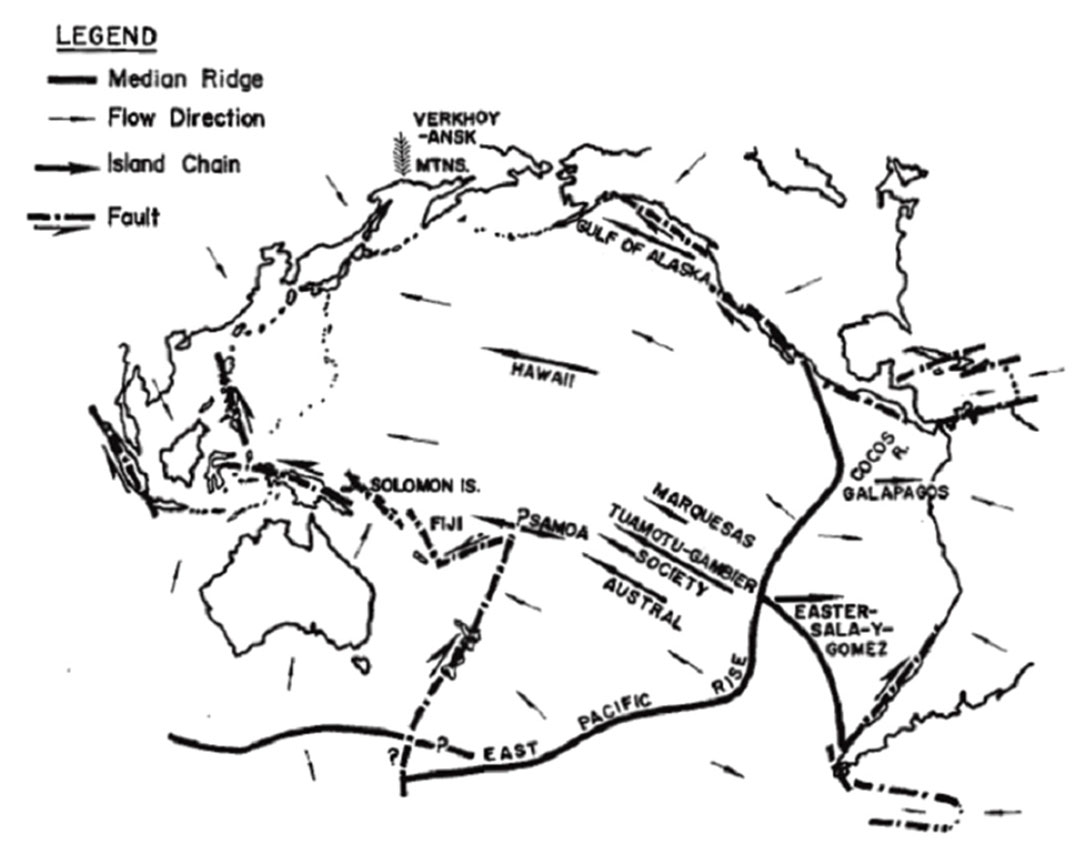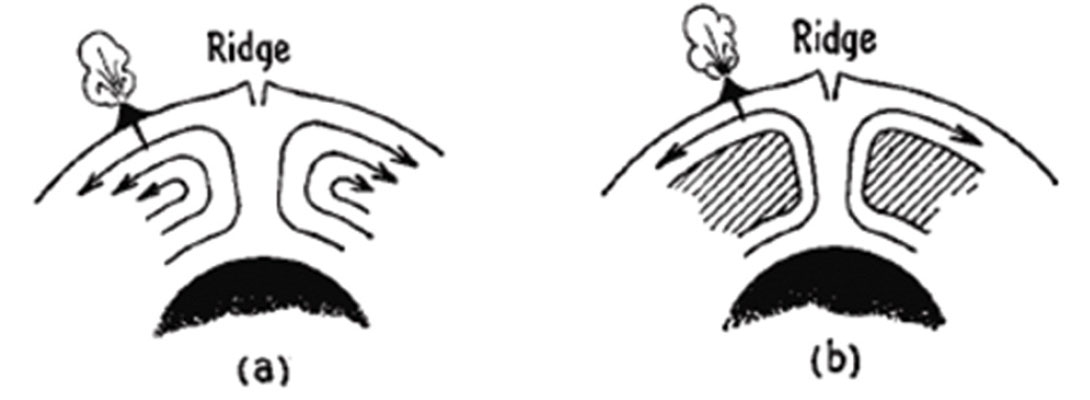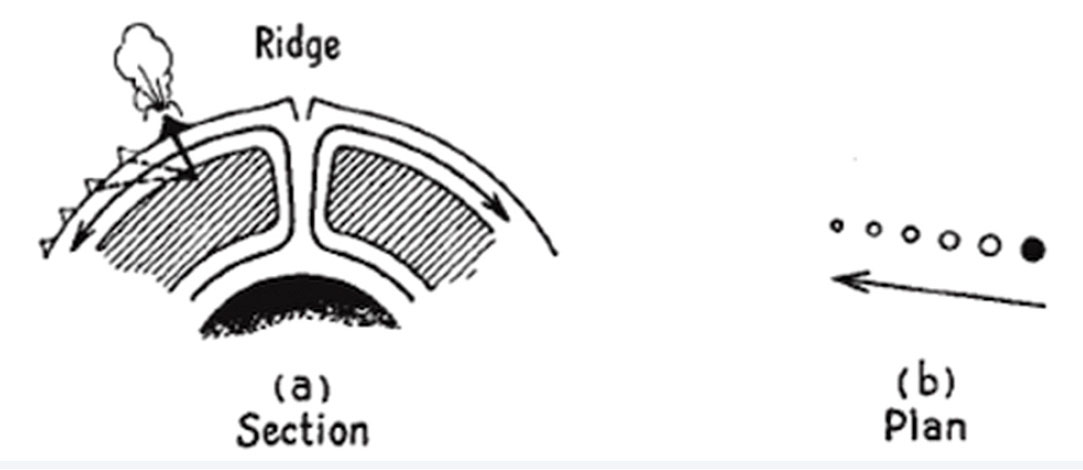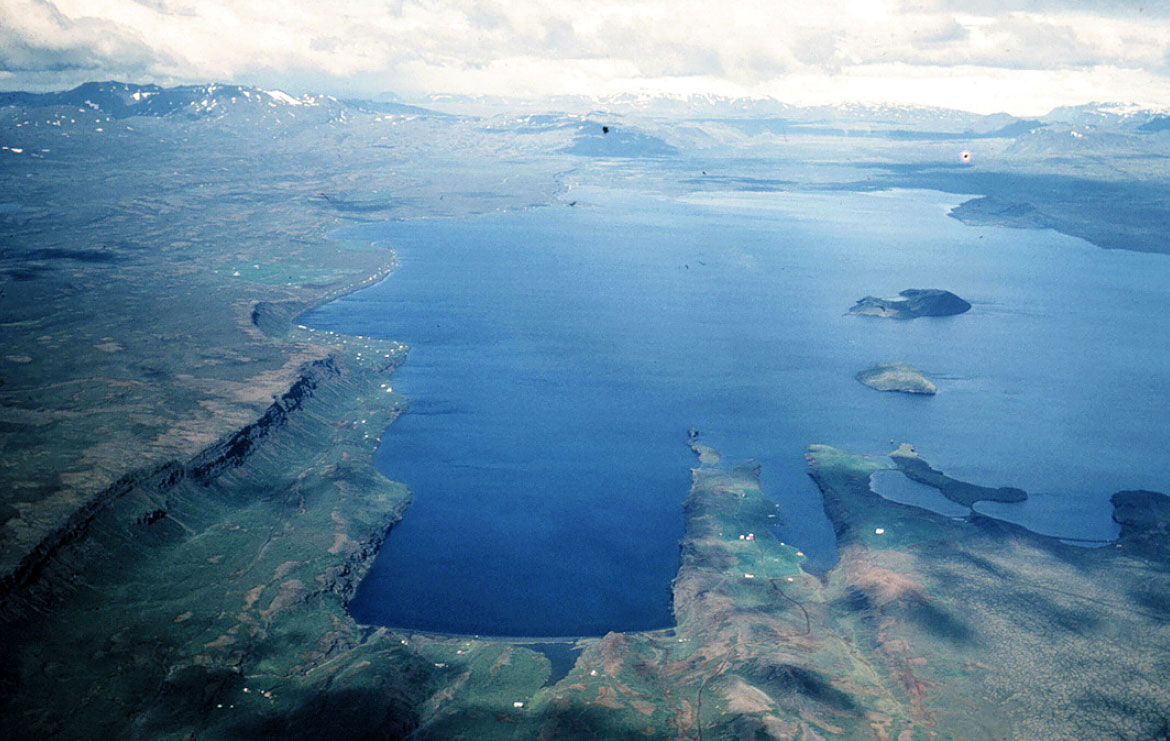Permission for CSEG RECORDER to republish this 1963 article from the Canadian Journal of Physics was kindly granted by the National Research Press of the National Research Council of Canada, following our request and the recommendation of Dr. Michael Steinitz, of St Francis Xavier University, Antigonish, Nova Scotia, current Editor of the CJP. NRC publishes and maintains on-line editions of the CJP back to 1951. The Canadian Journal of Physics is affiliated with the Canadian Association of Physicists. Information on the CAP society or its journal is at www.cap.ca or http://pubs.nrc-cnrc.gc.ca.
Abstract
It is noted that different physicists and geologists have in recent years espoused not less than four groups of theories of the physical behavior of the Earth’s interior. Recent observations of submarine geology, heat, and rock magnetism have tended to support some form of continental drift rather than the older concept of a rigid earth.
The Hawaiian Islands are one of seven, parallel, linear chains of islands and seamounts in the Pacific Ocean of Tertiary to Recent age. Their nature had previously been explained in terms of a series of volcanoes along parallel faults. Horizontal shear motion along these faults was supposed to be extending them southeasterly.
The inadequacies of this explanation are pointed out. If there are convection currents in the Pacific region and if the upper parts of these cells move faster than the central parts, sources of lava within the slower moving cores could give rise to linear chains of progressively older volcanic piles such as the Hawaiian Islands. This view is shown to be compatible with seismic observations arid age determinations.
Mountains and the differentiation of continents from ocean basins show that great forces have been at work within the solid Earth. Earthquakes, volcanism, and changes in level show that they are still operating, but the nature of these forces has never been satisfactorily elucidated. Four major theories and many lesser ones and variations have been proposed and each has the support of some physicists and geologists today.
The theories are sharply divided into those which postulate a rigid Earth on which the continents are fixed in position and those involving a mobile Earth on which continents move. It is important to settle this question whether conti nents drift or not, because until it is finally decided no complete accounts can be given of geophysics, geology, evolution, rock magnetism, or paleoclimates.
This paper is one of a series (Wilson 1962, 1963a, b, c) in which specific aspects of the Earth are considered in the light of the new evidence which suggests that the Earth is indeed mobile.
The traditional view has been that the Earth is rigid and has been con tracting by cooling, by compaction, and by the extrusion of volcanic rocks and gases. This theory, which was proposed by Newton and elaborated by Kelvin, today has the strong support of Jeffreys (1958) and most geologists in the northern hemisphere. It explains the compressional features observed in moun tains very well.
A more recent postulate is that the Earth is rigid, but expanding, either by radioactive heating or by a decrease in the value of G, the gravitational constant. The first point is indeterminate since the distribution of uranium, thorium, and potassium in the Earth is unknown. The second was raised by Dirac (1938) and has been discussed by Dicke (1957). Some geologists, including Heezen (Runcorn 1962b) and Carey (1958), have shown that expansion offers a good explanation of the tensional features recently discovered in mid-ocean ridges such as the mid-Atlantic ridge.

A third hypothesis is that the Earth is mobile and that continents drift or move about. A. Wegener (1924) thought that this was due to rotational forces on a spheroid. Although these forces are probably inadequate, P. M. S. Blackett et al. (1960), S. K. Runcorn (1962a), and others support drift as the only way of explaining the results of measurements of rock magnetism.
A fourth view advocated by such physicists as Griggs (1939), Vening Meinesz (1948), and Bernal (1961) is that the mantle of the Earth is convecting. Run corn (1962b) has recently shown that this is highly probable if Rayleigh’s criterion for convection applies. A number of geologists, including Holines (1946) and Menard and Dietz (in Runcorn 1962b), support this view. The currents of convection cells are held to rise and separate under mid-ocean ridges producing tension and to come together and sink under continental mountains producing compression. This theory provides a new and better mechanism for continental drift than that proposed by Wegener.
Curiously enough everyone agrees that some flow in the interior is necessary to account for the slow rise of regions recently covered by glacial ice sheets. The outstanding question concerns only horizontal motion.
Too little is known about the Earth’s interior and about the gravitational constant to decide between these views on general grounds.
Even if a decision could be reached, an analysis of the Earth’s features would be necessary before any general theory could be applied. The observations upon which to base such an analysis are abundant, but, until now, they have not proved diagnostic. This is considered to be because they were made neither on the appropriate scale nor in enough places.
Physicists’ generalizations have tended to be too sweeping and geologists’ too detailed. Most of the observations have naturally been confined to the readily accessible quarter of the Earth’s surface.
Interest in this fundamental question has recently been revived because much has been learned in the past few years about the Earth’s interior, the ocean floor, Antarctica, and about rock magnetism. Much of the new data makes the generally accepted view of a rigid Earth appear to be unsatisfactory.
In this paper the work published chiefly by American geologists and oceano graphers is used to identify one class of features, linear chains of islands of the Hawaiian type, and to try to explain their origin in terms of convection instead of the rigid Earth-model used until now.
There are believed to be at least nine chains of islands of this type (Fig. 1). They are straight and they include all the active and recent volcanoes of the Pacific Ocean basin which lie far from land, beyond island arcs, and outside of the andesite line that borders Melanesia and New Zealand (Bridge 1948).
Seven of these straight chains of islands and submarine seamounts are built on large ridges which trend west-northwest parallel with one another across the Pacific Ocean. They are the Hawaiian (Stearns 1946; Eaton and Murata 1960), Marquesas (Chubb 1930), Gambier-Tuamotu (Davis 1928; Repelin 1919; and Aubert de la Rue 1959), Society (Williams 1933), Austral (Chubb 1927), and Samoan (Stearns 1944; Kear and Wood 1959) Islands and the Pratt- Welker chain of seamounts off the coast of British Columbia and Alaska (Menard and Dietz 1951). All except Samoa, which is peculiarly situated, have active or recent volcanoes on the most easterly island and appear to get pro gressively older towards the northwest in the direction away from the East Pacific rise. Menard (1960) has suggested that this rise is underlain by an ascending and spreading convection current. On the opposite side of the rise the Galapagos Islands ridge (Banfield et al. 1956) and the ridge on which Easter (Bandy 1937) and Sala-y- Gomez (Fisher 1958) Islands lie seem to be in the same category, but to have mirror-image properties to the other seven so that these chains increase in age towards the east away from the East Pacific rise.
The generally accepted view of these islands is based upon a study of the Hawaiian Islands by Betz and Hess (1942) which was satisfactory when ad vanced, because much less was then known of the Pacific Islands and because all concerned tacitly accepted the concept of a rigid, immobile Earth.
This explanation was that each chain of islands had developed by extrusion of lava from a large fault. The faults were parallel and each was straight because of horizontal shear motion. The differences in age along each chain were not thought to be great, so that it was possible to believe that the volcanic activity at the southeastern ends was due to slow extension of the faults in that direction. This view has been well summarized by officers of the United States Geological Survey who have stated that “volcanism appears to have progressed from the northwest towards the southeast along the ridge. . . From its great length and narrow width it is apparent that the Hawaiian Ridge marks the course of a major fracture in the Earth’s crust through which lava has poured at different centers” (Eaton and Murata 1960).
The nature of these supposed fissures has turned out to be very elusive. H. T. Stearns (1946), who with his colleagues has mapped the Hawaiian Islands, did not find any sign of the great axial fault that might be expected and writes: “This tectonic feature has existed probably since at least Middle Tertiary; but it is not known whether the fissure is a tear along the crest of the fold, a simple tension crack, a group of echelon faults bounding a raised block or a strike-slip fault.”
Eaton and Murata (1960) also state that the principal faults on the islands are not axial faults, but rift zones which appear to determine the location and shape of the volcanoes. “Most commonly, each volcano has two principal rift zones meeting in the summit region at angles of 130° to 180° ... but just how these zones are related to the fundamental fracture beneath the ridge is not clear.”
The vertex of the obtuse angles in which rift zones meet is said to point “away from the unbuttressed flank of the Hawaiian ridge.” This is the position to be expected if parts of the islands had slipped down towards deep water beside the ridge.
It is here suggested that the rift zones are not fundamental tectonic features at all, but large landslides. Fairbridge (1950) has pointed out how common such features are on ocean islands. Other large landslides have been noted in the Indian Ocean on Heard Island (Lambeth 1952) and Christmas Island (Andrews 1900) and in the Pacific on several islands in the Marquesas (Chubb 1930), Society Islands (Williams 1933) and in Western Samoa (Rear and Wood 1959).
E. L. Hamilton (1957) has made a detailed survey of the sea floor southeast of Hawaii and his chart shows no extension of the fault there, where it might be expected.
Recently large submarine scarps have been discovered in the Pacific floor off California and they have been shown to have large lateral displacements (Vacquier, Raff, and Warren 1961). These are clearly faults, but the Hawaiian type of ridge bears no resemblance to them.
Earthquakes do not reveal this supposed fundamental fracture. The great majority of earthquakes are said to be intimately associated with eruptions. Eaton and Murata (1960) have emphasized that “Hawaii has earthquakes because it has volcanoes.” Most if not all other shocks appear to be due to isostatic adjustments and all are said to be shallow.
Until very recently no old fossils had been found on Hawaii and no ages were accurately known. Stearns, although he recognized that the islands in creased in age towards the northwest, also recognized that each island volcano had had the same history. Faced with this dilemma he minimized the differences in age, considered that all volcanoes were nearly synchronous, and equated the histories of all the volcanoes.
The recent discovery of Miocene fossils on Oahu (Menard et al. 1962) and some radioactive age determinations (McDougall 1963) show that the age of that partially eroded island is at least 20 million years and that the more com pletely eroded islands farther to the northwest may well be 50 or even 100 million years old. This would be similar to the ages determined by fossils found on some other ocean islands, including Heard Island (Lambeth 1952) in the Indian Ocean and Fernando de Noronha off Brazil (Alnieida 1955). It thus seems likely that the volcanoes of the Hawaiian chain had similar, rather than identical, histories and that each volcanic island in turn went through a similar cycle of volcanism and erosion, one after the other. This recognition of greater age makes it difficult to imagine how transcurrent faults could be slowly and steadily extending their parallel ways across the Pacific for tens of millions of years after their western ends had ceased to move.
It is therefore concluded that there is no evidence for transcurrent faults beneath the islands and that some other explanation must be found.
Chubb (1934 and 1957) has suggested that the ridges are the crests of folds and Menard (1955) and Wilson (1962) have suggested that the Hawaiian ridge may have been part of the mid-ocean ridge system, but the Hawaiian Islands have properties different from all other mid-ocean ridges and these explanations are inadequate.
The alternative explanation here proposed depends upon a system of con vection currents in the earth. Runcorn (1962a) has applied Rayleigh’s theory of convection to the mantle and concluded that convection should occur if the viscosity of the mantle is less than 10” or 1027 c.g.s. units. Since Niskanen (1949) gives a value of 5 X10” units for the viscosity calculated from the rate of postglacial recoil it seems safe tentatively to conclude that there should be slow convection currents in the mantle. If so, the currents might break the crust and rift it apart where they rise under mid-ocean ridges exposing fresh surfaces of the mantle to hydration and alteration as proposed by Hess (1960) and compressing the surface layers where they sink under mountains and ocean trenches. If the oceanic crust is merely the altered top surface of the mantle, its descent into the mantle again under ocean trenches presents no problem. As Menard (1960) has already suggested, the currents presumably come up under the East Pacific rise and flow away east and west beneath the Pacific floor. This expansion is taken up where the ocean floor is dragged down beneath the Andes and the East Asian arcs. R. S. Dietz (in Runcorn 1962b) has also recently given a theory of the spreading of ocean floors. There is also evidence for the spreading of the Atlantic, Arctic, and Indian oceans away from median ridges (Wilson 1963a). The problem for this paper is how to explain the Hawaiian Islands in terms of such currents.

If convection occurs, it could take any one of many forms. A major problem about convection currents in the solid Earth is that, if they occur, they are only moving at a rate of about an inch a year and cannot be identified directly and charted. Cross sections of some of the simplest possible forms are illus trated in Fig. 2. Convection in the mantle is generally illustrated by its pro-ponents in the form of uniformly rotating cells (Fig. 2a) but the large density gradient in the mantle is believed to be a hydrodynamical reason favoring a jet-stream type of convection (Fig. 2b), such as found experimentally by Hide (1952). Figure 2(c) represents another possibility which is here favored.
Figure 3 illustrates how chains of extinct volcanic islands could be generated by the formation of a succession of volcanoes over a rising current. As the volcanic piles accumulate they are borne successively away to one side or the other and become extinct.

Where the source of a chain of volcanoes is on a mid-ocean ridge or on the East Pacific rise as in the case of Easter Island, it is easy to understand why the origin remains relatively fixed. The rising current provides a continuing supply of heat. It is less obvious why a stream of volcanoes should arise like a series of bubbles from a point beneath the island of Hawaii which is far from the rising current.

It is at first difficult to imagine how a source not over a midocean ridge can remain relatively fixed. Figure 4(a) shows that for uniform overturn only one volcano will be produced rather than a chain. It will remain over its source as the whole convection cell turns. This is also true for a shallow source in a jet stream (Fig. 4b). If, on the other hand, the source of lava is within the relatively stagnant center of a jet-stream type of cell and if the surface layer is moving past the source, then a chain of volcanoes could result, as shown in Fig. 5. It is not necessary for the source to be immobile. It need only move more slowly than the nearsurface current.

It is suggested that each streaming point gives rise to a succession of vol canoes. For example, Mauna Loa and Kilauea, which lie at the upstream end of the Hawaiian Islands, may be fed intermittently from a deep source today.
A convection current moving northwesterly over this source may have carried the succession of older volcanoes in turn away to the northwest. Each volcano, as it was carried away from its source, slowly became inactive. The source soon created a new volcano in the place of the old. As a result each volcano has gone through the same life cycle. The source of each linear chain has given rise to a succession of volcanoes along a streamline. The farther a volcano is from the East Pacific rise, the older it is. The longer a chain, the older is the chain.
This hypothesis appears to offer a possible explanation for the origin of the Hawaiian and similar chains. If true, it follows that the convection in the upper mantle must be of the jet-stream type and that the source of basaltic lavas must be below the jet stream. If the low-velocity layer (Dorman, Ewing, and Oliver 1960; Press 1961) is identified with the jet stream, then the source of basalt is perhaps 200 km deep.
There is evidence that the source of basalt lavas may be this deep. Eaton and Murata (1960) have used small earthquakes to trace the rise of lava from 60 km while D. L. Anderson (1962) has mentioned more recent evidence that suggests greater depths.
The National Research Council of Canada, the Geological Survey of Canada, and the Vela-Uniform Project of the United States Air Force are thanked for the support given to this laboratory. This paper is Contribution No. 21 to the Canadian Upper Mantle Project.
I am grateful to A. W. Brewer and R. D. Russell for reading the manuscript and offering suggestions.












Join the Conversation
Interested in starting, or contributing to a conversation about an article or issue of the RECORDER? Join our CSEG LinkedIn Group.
Share This Article